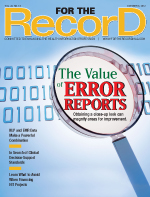 October 8, 2012
October 8, 2012
Coding for Anxiety Disorders
For The Record
Vol. 24 No. 18 P. 26
Anxiety is a feeling of uncontrollable nervousness, fear, apprehension, and worry that can range from mild unsettling to severe debilitation. Anxiety occurs normally in everyday life and is useful when alerting a person to danger, but it becomes concerning when it disrupts normal activities. The exact cause of anxiety is unknown, but it is believed stress may be one trigger.
Forms of Anxiety
The following are some common forms of anxiety with their associated ICD-9-CM code:
• Generalized anxiety disorder (300.02) — involves six months of persistent, excessive, and unrealistic worry.
• Panic disorder (300.01) — may have a sudden onset causing apprehension, fear, or terror. Physical symptoms may include shortness of breath, heart palpitations, or chest pain, causing a person to think he or she is having a heart attack. If the panic attack is associated with agoraphobia (fear of places or situations where someone feels trapped or helpless), assign code 300.21.
• Obsessive-compulsive disorder (300.3) — involves persistent, recurring thoughts/impulses (obsessions) and ritualistic actions (compulsions). This is different than obsessive-compulsive personality disorder (301.4).
• Posttraumatic stress disorder (309.81) — occurs after a severe emotional or physical trauma and involves the feeling that the person is reexperiencing this traumatic event.
• Acute stress disorder (308.3) — includes similar symptoms to posttraumatic stress disorder but occurs immediately after a traumatic event.
• Social phobia (300.23) — a person may experience anxiety when exposed to certain social events and desires to avoid the situation.
• Other phobia (300.2x) — anxiety when exposed to a specific object or situation and the desire to avoid it.
• Alcohol-induced anxiety (291.89)
• Drug-induced anxiety (292.89)
• Separation anxiety (309.21) — occurs when a child is separated from his or her parents.
Most frequently, the physician simply documents anxiety, which is classified to code 300.00. In some instances, anxiety is caused by an underlying medical condition. If that is the case, a code for both the anxiety and medical condition may be assigned. Sequencing will depend on the circumstances of admission. Common medical conditions causing anxiety include asthma, diabetes, heart disease, hyperthyroidism, and hypothyroidism.
Anxiety may be associated with depression. If both are documented by a physician, assign codes 311 and 300.00. However, if the physician links the two conditions, such as “depression with anxiety,” then code 300.4, Dysthymic disorder, may be assigned (AHA Coding Clinic for ICD-9-CM, 2001, third quarter, page 6).
Symptoms, Diagnosis, and Treatment
Common signs and symptoms of anxiety include feelings of apprehension, powerlessness, panic, or fear; hyperventilation; inability to be still or calm; increased heart rate; muscle tension; sweating; tiredness/weakness; and trembling.
A diagnosis of anxiety is made with a physical examination and psychological evaluations. The physical examination and diagnostic tests, if necessary, are performed to rule out other conditions that may mimic an anxiety state. Anxiety can lead to other medical conditions such as constipation, diarrhea, depression, drug/alcohol abuse, headaches, and insomnia.
Coding and sequencing for anxiety disorders are dependent on the physician documentation in the medical record and application of the Official Coding Guidelines for inpatient care. Also, use specific AHA Coding Clinic for ICD-9-CM and American Medical Association CPT Assistant references to ensure complete and accurate coding.
— This information was prepared by Audrey Howard, RHIA, of 3M Consulting Services. 3M Consulting Services is a business of 3M Health Information Systems. More information about 3M Health Information Systems is available at www.3mhis.com or by calling 800-367-2447.
ICD-10-CM Coding for Anxiety and Depression
Anxiety is classified to ICD-10-CM category F41 and is similar in structure in ICD-10-CM as in ICD-9-CM; one difference is anxiety with depression. Two codes are available depending on severity: F34.1, Persistent anxiety depression, and F41.8, Anxiety depression (mild or not persistent).
Dysthymic disorder also is classified to code F34.1 and includes depressive neurosis, depressive personality disorder, dysthymia, neurotic depression, and persistent anxiety depression.
In ICD-10-CM, coding for depression requires specific documentation as to type and acuity. The default for unspecified depression is major depressive disorder, single episode (F32.9), which also includes depressive disorder not otherwise specified (NOS) and major depression NOS. Physician education as well as queries for clarification will be most helpful in accurate documentation of a type and acuity of depression to avoid misrepresentation of a less severe disorder as a major one.
— AH



